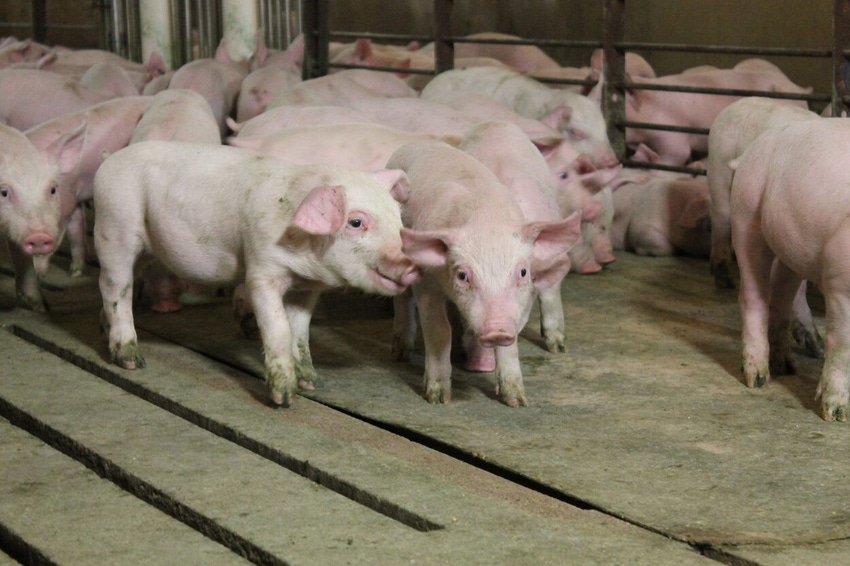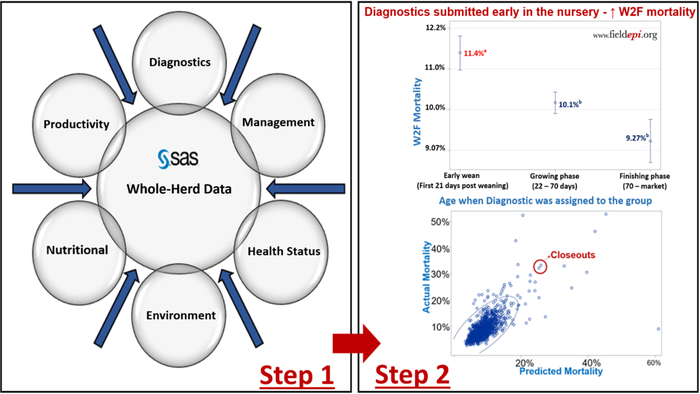Using field data integration and analysis through the PROSPER platform.
February 7, 2023

Wean-to-finish mortality in swine operations is greatly affected by birth-to-market factors related to productivity, infectious diseases, herd immunity, management and environmental factors (Gebdhardt et al., 2020). A common practice in the swine industry is to collect data from multiple sources and areas related to swine W2F mortality (Banhazi and Black, 2009; Piñeiro et al., 2019). However, these data stream are often stored separately, in different formats, through different software, and utilized sporadically and independently.
Also, integration of swine-generated data is difficult due to the complexity of flows and commingling of sources from breeding-to-market (Lenzerini, 2002). Without a sustainable procedure to connect these data streams, producers will remain unable to holistically utilize the data collected under their field conditions to investigate swine mortality (Fourichon, 1991).
The Predictors of Swine Performance (PROSPER) platform was developed at Iowa State University to automate the process of integrating multiple data streams within production systems, thus, creating a system-specific dataset (master table). This consolidated master table serves as a "background check" report, from birth-to-harvest, for each closeout of marketed pigs analyzed, to identify and measure the drivers of W2F mortality.

A study that used the PROSPER platform analyzed 1,316 closeouts of pigs marketed between 2018 – 2019 and identified 13 risk factors for wean-to-finish mortality, where 11 represented the pre-weaning phase of production and two the post-weaning phase (Magalhaes et al., 2021a). Overall, groups of pigs weaned from sow farms with a better performance were greatly associated with lower downstream wean-to-finish mortality (Table 1).
That is, groups of pigs weaned within the youngest weaning age category of 15.3 days had the highest subsequent W2F mortality compared to the oldest weaning age category of 20.3 days (13.1% vs 10.2%, respectively). Also, groups weaned within the highest pre-weaning mortality (PWM) of 18.0% had the highest downstream W2F mortality compared to groups weaned within the lowest PWM of 10.8% (13.5% vs 10.5%, respectively).
For sow farm health characteristics, groups of pigs weaned during the epidemic phase of infection for porcine reproductive and respiratory syndrome virus (0-16 weeks after an outbreak) had higher W2F mortality compared to groups weaned from endemic sow farms, or wild-type PRRS-negative sow farms, respectively (15.4% vs 10.7% and 8.7%). Likewise, weaned pigs originating from epidemic sow farms for Mycoplasma hyopneumoniae had higher downstream W2F mortality when compared to endemic or negative sow farms, respectively (13.7% vs 10.6% and 9.9%).
Lastly, when using the variables included in the multivariable model to predict the mortality of the groups, the model accounted for 68.2% (R2) of the W2F mortality variability, indicating that sow farm factors explained a large portion of the overall mortality analyzed.
Another study using the PROSPER platform analyzed a different population (2,721 closeouts) and identified a similar pattern of increased W2F mortality for groups being challenged in the sow farm (Magalhaes et al., 2022). More specifically, higher W2F mortality was observed for pigs weaned within the highest pre-weaning mortality category of 24.8% compared to the lowest category of 13.1%, respectively (9.95% vs 8.83%). Also, when comparing closeouts weaned within the weaning age quartile of 18.6 days compared to weaning age of 21.9 days, higher W2F mortality was observed, respectively (9.73% vs 8.93%).
For groups originating from PRRSV-epidemic sow farms, higher W2F mortality (12.9%) was observed compared to endemic, stable or negative breeding herds, respectively (9.22%, 9.27% or 9.76%). Likewise, groups with a positive PCR result for PRRSV, at any point during the growing phase, had higher W2F mortality than groups without a positive PCR result. (10.0% vs 9.1%), and higher mortality when the results occurred in the nursery phase compared to the finisher phase (10.9% vs 9.6%).
A third analysis from a different group of animals (1,742 closeouts) focused on the impact of diseases occurring during the growing phase (Magalhaes et al., 2021b). Compared to groups without submission, an increase of 1.03% in W2F mortality was observed for groups that had tissue submitted to the Veterinary Diagnostic Laboratory at any point in time during the growing phase. Furthermore, the timing when the tissue was submitted for diagnosis was also significant, with decreased W2F mortality as the groups got older, i.e., W2F mortality of closeouts with submission during more than or equal to 21 days in the nursery compared to less than or equal to 21 days in the nursery decreased from 11.4% to 10.1%, and dropped to 9.27% when tissue was submitted through the finishing phase.
Lastly, closeouts with a reported diagnosis of coinfections between PRRS and other pathogens had the highest mortality values compared to closeouts with a bacterial diagnosis in the absence of PRRS. That is, closeouts diagnosed with either Glaesserela parasuis or Streptococcus suis, both without PRRSV, had decreased W2F mortality (10.2% and 10.5%) compared to when diagnosed with PRRSV, respectively (13.3% and 13.0%).
Discussion and conclusions
In the analyses using the PROSPER platform, the key findings regarding post-weaning mortality were:
Different results occurred as distinct populations were analyzed in terms of location and time. However, even though the impact of some factors changed, sow farm productivity and health status demonstrated to have a large impact on the downstream W2F mortality of all populations analyzed
These results confirm the 'field perception' that the quality of weaned pigs is highly predictive of subsequent W2F performance.
The importance of consistent data consolidation and analysis of birth-to-market risk factors was demonstrated, while there is still an opportunity for improving statistical analysis by including new information, such as weaning weight, temperature records, management and treatment records.
Health challenges throughout the growing phase are also important risk factors for swine post-weaning mortality, especially for groups infected early in the nursery phase compared to the finisher phase. Also, coinfections between bacterial pathogens and PRRSV were significant.
This study demonstrated the importance of having a near-real-time data-wrangling pipeline to consolidate data routinely, which provides the capability of collectively analyzing previously dispersed breeding-to-market data.
Acknowledgements
This study was funded by the USDA - National Institute of Food and Agriculture grant #022-68014-36668. This study is also part of the Improving Pig Survivability project, which was funded by The National Pork Board and The Foundation for Food and Agriculture Research grant #18-147.
References
Banhazi, T.M., Black, J.L., 2009. Precision Livestock Farming: A Suite of Electronic Systems to Ensure the Application of Best Practice Management on Livestock Farms. Aust. J. Multi-Disciplinary Eng. 7, 1–14. https://doi.org/10.1080/14488388.2009.11464794
Fourichon, C., 1991. Application of ecopathological methods to the investigation of health problems on farms. Rev. Sci. Tech. 10, 151–177. https://doi.org/10.20506/rst.10.1.542.
Gebhardt, J.T., Tokach, M.D., Dritz, S.S., De Rouchey, J.M., Woodworth, J.C., Goodband, R.D., Henry, S.C., 2020. Postweaning mortality in commercial swine production. I: Review of non-infectious contributing factors. Transl. Anim. Sci. 4, 462–484. https://doi.org/10.1093/TAS/TXAA068
Lenzerini, M., 2002. Data integration: A theoretical perspective. Proc. ACM SIGACT-SIGMOD-SIGART Symp. Princ. Database Syst. 233–246.
Magalhaes ES, Trevisan G, Holtkamp DJ, Zimmerman JJ, Silva GS, Linhares DCL. Consolidating production, management and health data from all phases of production to assess the causes of wean-to-finish mortality. 2022 International Pig Veterinary Society Congress – IPVS 2022; June 21-24, 2022; Pg 575.
Magalhaes ES, Thomas P, Trevisan G, Holtkamp D, Rademacher C, Zimmerman JJ, Schwartz K, Burrough E, Linhares DCL. Measuring the effect of disease diagnostic information on the mortality of growing pigs raised under field conditions. Annual Meeting American Association of Swine Veterinarians. Feb. 27-Mar 4, 2021b; Pg. 299-300
Magalhaes ES, Zimmerman JJ, Thomas P, Moura CAA, Trevisan G, Holtkamp DJ, Wang C, Rademacher C, Silva GS, Linhares DCL. Whole-herd risk factors associated with wean-to-finish mortality under the conditions of a Midwestern USA swine production system. Preventive Veterinary Medicine. 2021a; 198:105545. Online head of print. doi: 10.1016/j.prevetmed.2021.105545.
Piñeiro, C., Morales, J., Rodríguez, M., Aparicio, M., Manzanilla, E.G., Koketsu, Y., 2019. Big (pig) data and the internet of the swine things: A new paradigm in the industry. Anim. Front. 9, 6–15. https://doi.org/10.1093/af/vfz002
You May Also Like


